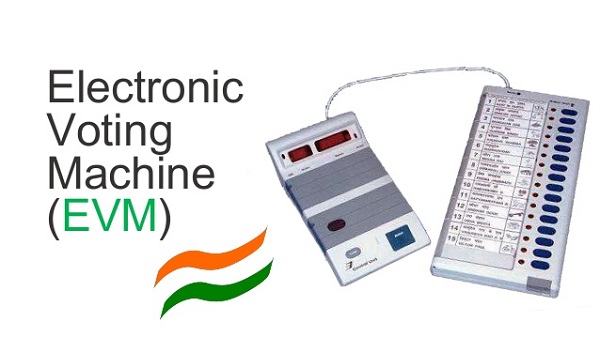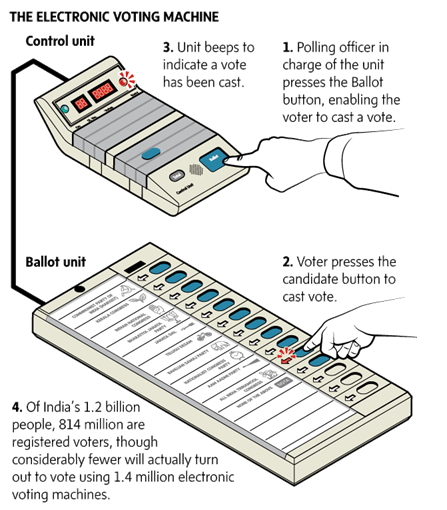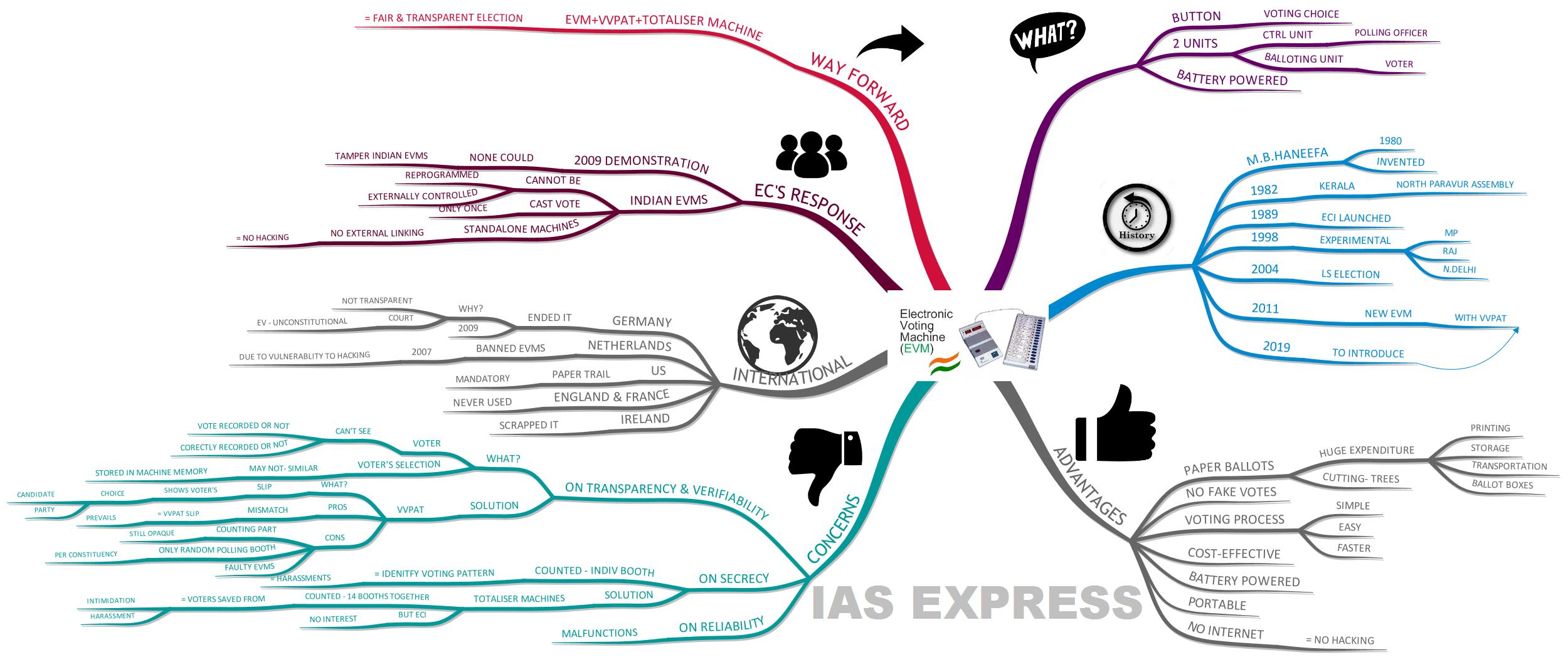Electronic Voting Machines (EVMs) in India – Are they Tamper Proof?

From Current Affairs Notes for UPSC » Editorials & In-depths » This topic
IAS EXPRESS Vs UPSC Prelims 2024: 85+ questions reflected
Recently, the Law Minister has defended the Electronic Voting Machine (EVM), describing it as an instrument designed to empower the ordinary Indian. There are two interesting discussions regarding the Electronic Voting Machine (EVM) controversy in India. First, since its inception, every major political party has questioned the authenticity and efficacy of the machine. Secondly, the instrument often works as the bone of contention between the winning and the losing party, with the winning party always defending the indispensability of the machine to the democratic process and the losing alleging that the EVMs were tampered with.
What are Electronic Voting Machines (EVMs) and how does it work?

- EVMs are electronic voting machines which provide the voter with a button for each choice and it is linked by a cable to an electronic ballot box.
- It comprises of 2 units – control unit and balloting unit– which are connected by a 5-meter cable.
- The control unit is with the polling officer appointed by the Election Commission and the Balloting Unit is in the voting compartment into which the voter enters to cast his/her vote in secret by pressing the button against the name and symbol of the candidate of his/her choice.
- The EVM is powered by a 6-volt single alkaline battery fitted in the control unit, and can even be utilized in areas that have no electricity.
What is the history of EVMs in India?
- In 1980, M. B. Haneefa invented the 1st Indian voting machine, gazetted “Electronically operated vote the counting machine”.
- EVMs’ industrial designers were faculties at the Industrial Design Centre, IIT Bombay.
- The EVMs were first utilised in 1982 in the by-election to North Paravur Assembly Constituency in Kerala for a certain number of polling stations.
- The EVMs were launched in 1989 by Election Commission of India working jointly with Electronics Corporation of India Limited.
- In 1998, EVMs were used on an experimental basis in 16 Assembly Constituencies in the States of Madhya Pradesh, Rajasthan as well as NCT of Delhi.
- In the 2004 Lok Sabha election, the whole country voted using EVMs.
- The new generation of EVM was developed in 2011 with a feature for Voter Verified Paper Audit Trail (VVPAT).
- EC is planning to introduce EVMs equipped with VVPAT machines for the 2019 Lok Sabha elections.
What are the advantages of an Electronic Voting Machine?
- The major problems of paper ballots are their printing, storage, and transportation which involve huge expenditure, lakhs of ballot boxes needed for each election and logistics problems with their safe storage between elections.
- Using EVMs mean doing away with paper ballots thus saving paper and hence trees.
- It eliminates the possibility of invalid and doubtful votes which were the root causes for many election petitions.
- It makes the voting process very simple and easy.
- They are cost-effective in the long run.
- EVMs don’t need electricity and powered by batteries.
- EVMs are lighter and portable when compared to huge ballot boxes.
- EVMs have made the vote-counting process much faster, delivering results in hours when compared to manual counting of votes.
- Hacking of EVMs is not possible since these have no internet connection.
What are the concerns regarding Electronic Voting Machines?

On transparency & verifiability – EVMs are neither transparent nor verifiable.
- The voter cannot see her vote being recorded and also the recorded vote cannot be verified whether it was recorded correctly.
- The only thing that is verifiable is the total number of casted votes and not the choice expressed in each vote.
- An electronic display of the voter’s selection may not be similar to the vote electronically stored in the machine’s memory.
- To resolve this, the Voter Verifiable Paper Audit Trail (VVPAT) was introduced.
- About VVPATs: VVPAT is a slip generated in a printer-like machine attached to EVM and shows voter’s choice of candidate as well as the party. Generated slip is displayed for a few seconds to the voter to verify before it falls into a sealed dropbox which can be opened during counting.
- Advantages: Initially, election results are announced based on the recording of votes given by EVMs. If the election results are disputed, then the votes recorded under VVPATs shall be counted and announced. If there is any mismatch between the two results, then the VVPAT’s result will prevail over the EVMs.
- Disadvantages: However, VVPATs address only the issues at the voting part and the counting part still stays an opaque operation.
- Furthermore, currently, the EC’s VVPAT auditing is limited to one randomly selected polling booth per constituency. But, this sample size will not detect faulty EVMs 98-99 percent of the time.
- VVPATs can be an effective deterrent to fraud, but, the detection of even one faulty EVM in a constituency is followed by the VVPAT auditing of all the EVMs (at all booths) in that constituency = poses a serious logistical challenge and hence VVPATs are not the solution to counting level failures.
On secrecy –
- With the paper ballot, the EC could mix ballot papers from various booths before counting = voting preferences could not be linked to the concerned locality.
- But, the votes cast through EVMs are counted based on individual booth = enables one to identify voting patterns and this renders marginalised communities vulnerable to pressure and harassments by party members.
- As a remedy to this problem, a totaliser machine was proposed.
- The totaliser machine enables votes from 14 booths to be counted together = voters are saved from pre-poll intimidation and post-poll harassment.
- However, the EC has shown no interest in adopting them at the national level.
On reliability –
- The recent track record of EVMs highlights that the number of malfunctions in a national election will be high.
- Moreover, a US-based person recently made sensational but unsubstantiated claims regarding Electronic Voting Machines (EVMS) that are used in Indian elections. The man, who claimed to have been involved in designing the EVMs are used in India, claimed that the 2014 Lok Sabha elections were rigged. The man addressed a press conference in London where he claimed that many political parties in India were aware of how EVMs could be hacked.
- However, the man did not offer much in the way of evidence or proof to back his claims. So ECI rejected those outlandish claims.
What is the international scenario?
- Germany ended electronic voting in 2009 due to the fact that this system lacked transparency. The court also declared that electronic voting is unconstitutional.
- The Netherlands banned EVMs in 2007 after an anti-EVM group showcased how the machines could be tampered within 5 minutes without anybody noticing the fraud.
- In the United States, the paper trail is mandatory for states that use electronic voting.
- England and France have never used EVMs.
- Italy felt that the e-voting results could have tampered.
- Ireland scrapped EVMs after spending 51 million pounds researching them for over three years.
What are the measures to secure EVMs?
Functional check: The machines are cleaned and previous results are cleared. Switches, buttons, cables as well as latches are investigated for damage.
Random check: A mock poll is held with 5% of the total number of EVMs to be used for a poll. Around thousand votes are polled and the result printouts are shared with representatives of different political parties.
Throwing the dice: EVMs are randomly kept in the constituencies and booths and it is difficult to identify which machine is placed where.
A dry run: Before the beginning of the actual poll, a mock poll is held with at least 50 votes in the presence of candidates or their agents. Then the mock poll is concluded and the results are displayed. On poll day, several checks are carried on by polling agents, observers, as well as central paramilitary forces.
Safe and secure: EVMs are kept in their carrying cases and sealed. The machines are transported back to the reception centres under armed escort and placed in a well-guarded room.
What is the Election Commission’s response to criticisms?
- In 2009, ECI invited skeptics to showcase the alleged fallibility of EVMs, utilizing 100 randomly procured machines from 10 states. The result was that none of the persons who were provided a chance could demonstrate that ECI-EVM could have tampered in any of the 100 machines put on display.
- ECI mentioned that EVMs can neither be reprogrammed nor controlled by the external device. The source code is designed in such a way that it enables the voter to cast the vote only once. The next vote can be recorded only after the Presiding Officer enables the ballot on the Control Unit. In between, the machine becomes dead to any signal from outside.
- ECI also said that the comparison between EVMs in India and abroad, where they have failed, is both misplaced and misguided. This is due to the fact that most of the systems used in other nations are PC based and running on the operating system. So they are vulnerable to hacking.
- However, EVMs in India are standalone machines without being linked to any input. The software in the chip is one-time programmable and is burnt into the chip at the time of manufacture. Nothing can be written on the chip after manufacture. Hence there is a fundamental difference between EVMs in India and abroad.
- Thus the Election Commission does not find any merit in such allegations and rejects all such allegations and suspicions raised by some political parties. Therefore, ECI has ensured all citizens that ECI-EVM is tamper-proof and fully responsive to the integrity of the electoral process using EVMs.
- Furthermore, if EVMs are supplemented with VVPATs and Totaliser machines, it will go a long way in ensuring fair and transparent elections in the country.
If you like this post, please share your feedback in the comments section below so that we will upload more posts like this.


